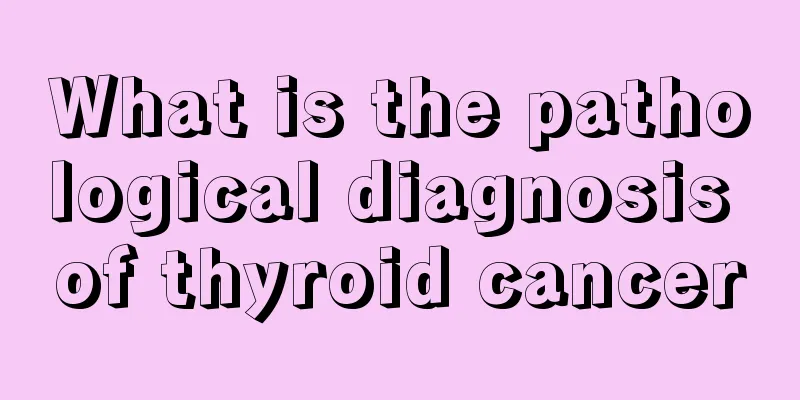What is the pathological diagnosis of thyroid cancer

|
What is the pathological diagnosis of thyroid cancer? Although the incidence of thyroid cancer is very high now, for busy people, many people do not pay attention to the prevention of this disease before health problems arise. Once thyroid cancer occurs, it may not be discovered in time. In order to let everyone know more about thyroid cancer, the pathological diagnosis method of thyroid cancer will be introduced to you. How are thyroid cancer diagnosed? 1. Asking for medical history and conducting physical examination: When we ask about abnormal swelling or nodules in the patient's thyroid gland, the first thing we need to do is to distinguish it from a tumor. The patient's medical history and physical examination results are often very helpful for differential diagnosis of the disease. During the physical examination, if diffuse swelling or mild nodular swelling of the thyroid gland is found, the disease can usually be confirmed if 131I scanning and iodine uptake rate tests are performed. 2. X-ray examination: For patients with large thyroid tumors or advanced thyroid cancer and suspected mediastinal goiter, lateral radiographs of the cervical trachea must be performed to understand the scope of the tumor, the difference in calcification images, and the relationship between the trachea and esophagus. Another key role of X-ray is to observe the relationship between the trachea and the thyroid gland. Large benign tumors or nodular enlargement of the thyroid gland often cause the trachea to shift, but usually do not cause tracheal stenosis, but there are exceptions. 3. Conduct radionuclide examination: This examination can give a clear understanding of the morphology and position of the thyroid gland, as well as the properties of the thyroid gland and thyroid nodules, so this examination has been used as a routine examination for diagnosing thyroid diseases. 4. Self-diagnosis method 2. Lump size If the lump is diffuse or multiple nodules, it may be a goiter, but if there is a cyst with a diameter greater than 2 cm, it may be thyroid cancer. 3. Lump smoothness and hardness Carefully touch the surface of the lump and make a diagnosis based on the degree of smoothness. Endemic goiter is mostly smooth; thyroiditis is mostly not smooth. If the lump is single and has a solid feel and is not smooth, it should be suspected of being a cancer. 4. Tumor growth rate The self-diagnosis method for thyroid cancer also includes diagnosis based on the growth rate of the tumor. Generally, the growth rate of thyroid cancer tumors is fast, and the swelling is obviously visible within a dozen days. 5. Whether lymph nodes are palpable If hard lymph nodes appear around the thyroid gland, thyroid cancer should be suspected, accompanied by local lymph node metastasis. After reading the editor's story, we have a better understanding of the diagnosis and confirmation methods of thyroid cancer. The occurrence of a disease like thyroid cancer can indeed endanger life safety, so it is very important to be able to diagnose and treat it in time when the disease occurs. I hope every patient can recover soon. |
<<: Under what circumstances does thyroid cancer require surgery
>>: What tests are generally needed for thyroid cancer
Recommend
Do you have to lie flat if you have hip effusion?
There is no need to lie flat when there is hip ef...
Can rectal cancer be cured
Can rectal cancer be cured? This question has alw...
What is the reason for blood streaks in the back of the throat?
The appearance of blood streaks on the back wall ...
Does beer make you fat?
Beer is a very common drink in our lives, especia...
How is the dehumidification effect of red bean and coix seed water
Red bean and barley water is quite effective in r...
How to turn over after cesarean section without pain from the incision?
After a cesarean section, a large wound will be l...
What are the methods to strengthen the spleen, replenish qi and blood?
What are the methods to strengthen the spleen, re...
What are the bases for diagnosing lung cancer? The diagnosis of lung cancer should adhere to these bases
Now that our living standards have improved, many...
How to treat sprained wrist?
Wrist sprain is very common in daily life. Incorr...
What are the dangers of lung cancer
I believe everyone knows that smoking is harmful ...
What is the most effective way to treat advanced lung cancer? Comprehensive treatment methods for advanced lung cancer
As living standards continue to improve, the qual...
The red bumps on the soles of the feet are very itchy_The red spots on the soles of the feet are itchy
The feet are not prone to illness, but because of...
What are the methods of surgical treatment for lung cancer? There are 4 methods of surgical treatment for lung cancer
Everyone knows the harm of lung cancer. Lung canc...
What are the differences between corns and common warts
Common warts are a common skin disease. Because t...
How long does it take to stew the ribs?
Compared with braised spare ribs, most families a...









